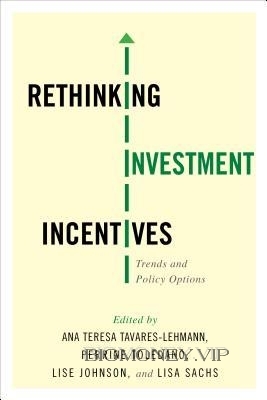Rethinking Investment Incentives: Trends and Policy Options by Ana Teresa Tavares-Lehmann

CHAPTER 1
Introduction
Ana Teresa Tavares-Lehmann, Lisa Sachs,
Lise Johnson, and Perrine Toledano
In July 2015, the government of Ethiopia hosted the Third International
Financing for Development Conference, bringing together world leaders
from governments, businesses, and international organizations to chart
a course for financing the post-2015 development agenda. That agenda
includes the most critical challenges facing society—ending extreme pov-
erty, eradicating preventable diseases, and halting global warming, among
others. Achieving the resulting sustainable development goals (SDGs) by
2030 will require mobilizing and harnessing substantial resources from
both the public and the private sectors. At the conference, the global
leaders recognized that “private business activity, investment and innova-
tion are major drivers of productivity, inclusive economic growth and job
creation” and that “private international capital flows, particularly foreign
direct investment, along with a stable international financial system, are
vital complements to national development efforts” (UN 2015, para. 35).
Indeed, now more than ever, investment has an important role to play
in sustainable development through the injection of capital, generation of
employment, and transfer of technology and know-how. Many govern-
ments have increasingly recognized that role: recent decades have seen a
dramatic increase in the array of government incentives offered to attract
such investment—and, in particular, foreign direct investment (FDI)—
and to increase its contribution to sustainable development. In fact,
the Addis Ababa Action Agenda adopted at the conference recognized
that “incentives can be an important policy tool” (UN 2015, para. 27)
in financing sustainable development. Well-designed investment incen-
tives can attract and channel resources so as to develop renewable energy
technologies, enable wider access to energy and other infrastructure, train
human resources, and strengthen health systems—all of which can sup-
port sustainable development (UNCTAD 2014).
Understanding how, when, where, and why governments use incen-
tives to attract and guide investment is critically important if we are to
assess whether and how society benefits from incentives. It is increasingly
apparent, however, that the use and impact of incentives are not well
understood—including by the policy makers who use them. Incentives
are often quite costly for governments, and yet they are only rarely
designed to strategically meet sustainability or development objectives. It
is widely acknowledged that companies may seek—and governments may
offer—incentives beyond those that may be needed to attract an invest-
ment, whereas other investments or more general policies that would be
more effective at attaining SDGs are underutilized or poorly designed or
implemented.
Although the use of incentives by both national and subnational gov-
ernments around the world is ubiquitous, with few exceptions, little is
known about their prevalence, distribution, effectiveness, and impacts.
Due largely to a lack of transparency regarding these measures, the use of
investment incentives has thus far largely escaped systematic monitoring,
reporting, or analysis.
But this may be changing. Some government entities, including, most
notably, the European Union (EU), are imposing broad transparency
requirements and strengthening their monitoring and evaluation. Along
with improvements in understanding the use of these measures, there
have been developments in terms of hard or soft regulation. International
organizations and experts are increasingly discouraging certain types of
fiscal, financial, or regulatory incentives for a number of reasons, one
of which is that they might be wasteful and inefficient. This concern is
particularly pressing as subnational and national jurisdictions compet-
ing for capital engage in “bidding wars” that can drive those jurisdic-
tions to increase the types and generosity of incentives they offer in order
to attract new investments and even lure coveted existing investments
away from other jurisdictions. In the latter case, such incentives are inef-
ficient in a regional or global sense, as the result is simply to reallocate
investment within or across regions rather than generating new invest-
ments. Other concerns are that locational or behavioral incentives might
be unduly costly (with costs outweighing their benefits) and might have
harmful distributional impacts, resulting in increased inequality rather
than inclusive growth.
Rethinking Investment Incentives: Trends and Policy Options by Ana Teresa Tavares-Lehmann




